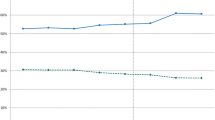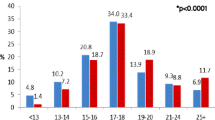Abstract
Tobacco use is the leading cause of preventable death, and China accounts for about 30% of worldwide smokers and 40% of global tobacco consumption. This study examines socioeconomic and community disparities in smoking among young Chinese people from 2010 to 2016. Data were from 953 people aged 16 to 25 in four waves of the China Family Panel Studies (CFPS). Two-level logistic regressions were fitted to account for both inter-individual and intra-individual differences over time. Weight-adjusted multilevel regression results showed a decrease in cigarette smoking among rural young people (OR = 0.71, 95% CI = [0.52, 0.98]) from 2010 to 2016. Higher family income was related to higher odds of cigarette smoking among young people (OR = 1.75, 95% CI = [1.10, 2.80]). Cigarette smoking among young people in families with higher incomes increased over time. Policies and interventions targeting the young should consider the socioeconomic disparities and multilevel context.




Similar content being viewed by others
References
World Health Organization (2017) WHO Report on the global Tobacco Epidemic. World Health Organization, Geneva
Parascandola M, Xiao L (2019) Tobacco and the lung cancer epidemic in China. Transl Lung Cancer Res S21–S30. https://doi.org/10.21037/tlcr.2019.03.12
Yang G, Kong L, Zhao W, Wan X, Chen CL, Koplan PJ (2008) Emergency of chronic non-communicable diseases in China. The Lancet 372(08):1697–1705. https://doi.org/10.1016/s0140
World Health Organization (WHO) and United Nations Development Programme (UNDP) (2017) The Bill China cannot afford: Health, Economic and Social costs of China’s Tobacco Epidemic. World Health Organization Regional Office for the Western Pacific, Manila, Philippines
World Health Organization (WHO), the U.S. Centers for Disease Control and Prevention (CDC), and RTI International (2018) Atlanta, GA: CDC Foundation. 2019
Han J, Chen X (2015) A meta-analysis of cigarette smoking prevalence among adolescents in China: 1981–2010. Int J Environ Res Public Health 12(5):4617–4630. https://doi.org/10.3390/ijerph120504617
Li X, Galea GH (2019) China 2030: an opportunity for tobacco control. The Lancet 394(10204):1123–1125. https://doi.org/10.1016/S0140-6736(19)32048-3
HHS Office of the Surgeon General (2017) Preventing tobacco use among youths, Surgeon General fact sheet. https://www.hhs.gov/surgeongeneral/reports-and-publications/tobacco/preventing-youth-tobacco-use-factsheet/index.html.
Villanti CA, Niaura SR, Abrams BD, Mermelstein R (2019) Preventing smoking progression in young adults: the concept of prevescalation. Prev Sci 20:377–384. https://doi.org/10.1007/s11121-018-0880-y
Choi SH, Stommel M (2016) Impact of age at smoking initiation on smoking-related morbidity and all-cause mortality. Am J Prev Med 53(1):33–41. https://doi.org/10.1016/j.amepre.2016.12.009
Yuan M, Cross JS, Loughlin ES, Leslie MF (2015) Nicotine and the adolescent brain. J Physiol 593(Pt 16):3397–3412. https://doi.org/10.1113/JP270492
Marmot M, Wilkinson GR (2006) Social determinants of health. Oxford University Press, New York, NY
McLeroy RK, Bibeau D, Steckler A, Glanz K (1988) An ecological perspective on health promotion programs. Health Educ Behav 15(4):351–377 https://doi.org/10.1177/109019818801500401
Moon G, Barnett R, Pearce J, Thompson L, Twigg L (2018) The tobacco endgame: the neglected role of place and environment. Health Place 53:271–278 https://doi.org/10.1016/j.healthplace.2018.06.012
Poonawalla IB, Kendzor DE, Owen MT, Caughy MO (2014) Family income trajectory during childhood is associated with adolescent cigarette smoking and alcohol use. Addict Behav 39(10):1383–1388. https://doi.org/10.1016/j.addbeh.2014.05.005
Soteriades SE, DiFranza RJ (2003) Parent’s socioeconomic status, adolescents’ disposable income, and adolescents’ smoking status in Massachusetts. Am J Public Health 93(7):1155–1160. https://doi.org/10.2105/ajph.93.7.1155
Li X, Mao R, Stanton B (2010) Parental, behavioral, and psychological factors associated with cigarette smoking among secondary school students in Nanjing, China. J Child Fam Stud 19:308–317. https://doi.org/10.1007/s10826-009-9299-1
Epperson AE, Gonzalez M, Skorek M, Song AV (2022) Challenging assumptions about Race/Ethnicity, socioeconomic status, and cigarette smoking among adolescents. J Racial Ethnic Health Disparities 9:436–443. https://doi.org/10.1007/s40615-021-00974-0
Rich CZ, Xiao S (2011) Tobacco as a social currency: cigarette gifting and sharing in China. Nicotine Tob Res 14(3):258–263. https://doi.org/10.1093/ntr/ntr156
Yang XY (2017) How community-level social and economic developments have changed the patterns of substance use in a transition economy? Health Place 46:91–100. https://doi.org/10.1016/j.healthplace.2017.05.009
Mays D, Gilman ES, Rende R, Luta G, Tercyak PK, Niaura SR (2014) Parental smoking exposure and adolescent smoking trajectories. Pediatrics 133(6):983–991. https://doi.org/10.1542/peds.2013-3003
Hopfer JC, Croeley JT, Hewitt KJ (2003) Review of twin and adoption studies of adolescent substance use. J Am Acad Child Adolesc Psychiatry 42(6):710–719. https://doi.org/10.1097/01.CHI.0000046848.56865.54
Maes HH, Woodard EC, Murrelle L, Meyer MJ, Silberg LJ, Hewitt KJ, Rutter M, Simonoff E, Pickles A, Carbonneau R, Neale CM, Eaves JL (1999) Tobacco, alcohol and drug use in eight- to sixteen-year-old twins: the Virginia Twin Study of adolescent behavioral development. J Stud Alcohol 60:293–305. https://doi.org/10.15288/jsa.1999.60.293
Han C, McGue MK, Iacono WG (1999) Lifetime tobacco, alcohol and other substance use in adolescent Minnesota twins: univariate and multivariate behavioral genetic analyses. Addiction 94:981–993. https://doi.org/10.1046/j.1360-0443.1999.9479814.x
McGue M, Elkins I, Iacono WG (2000) Genetic and environmental influences on adolescent substance use and abuse. Am J Med Genet 96:671–677. https://doi.org/10.1007/s40429-015-0049-8
Vuolo M, Staff J (2013) Parent and child cigarette use: a longitudinal, multigenerational study. Pediatrics 132(3):e568–e577. https://doi.org/10.1542/peds.2013-0067
Avenevoli S, Merikangas RK (2009) Familial influences on adolescent smoking. Addiction 98(1):1–20. https://doi.org/10.1046/j.1360-0443.98.s1.2.x
Astell-Burt T, Zhang M, Feng X, Wang L, Li Y, Page A, Zhou M, Wang L (2018) Geographical inequality in tobacco control in China: multilevel evidence from 98058 participants. Nicotine Rob Res 20(6):755–765. https://doi.org/10.1093/ntr/ntx100
Liao Y, Chen X, Tang J (2017) Differences of cigarette smoking and alcohol consumption by sex and region in China: a population-based. multi-stage Cluster Sampling Survey the Lancet 390(4):S54. https://doi.org/10.1016/S0140-6736(17)33192-6
Zhang J, Ou JX, Bai CX (2011) Tobacco smoking in China: prevalence, disease burden, challenges and future strategies. Respirology 6(8):1165–1172. https://doi.org/10.1111/j.1440-1843.2011.02062.x
Yang T, Barnett R, Rockett IR, Yang XY, Wu D, Zheng W, Li L (2015) The impact of regional economic reliance on the tobacco industry on current smoking in China. Health Place 33:159–171. https://doi.org/10.1016/j.healthplace.2014.12.015
Anderson JC, Palmer PH, Chou CP, Pang Z, Zhou D, Dong L, Xiang H, Yang P, Xu H, Wang J, Fu X, Guo Q, Sun P, Ma H, Gallaher EP, Xie B, Lee L, Fang T, Unger BJ (2016) Tobacco use among youth and adults in mainland China: the China Seven cities Study. Public Health 120(12):1156–1169. https://doi.org/10.1016/j.puhe.2006.07.023
Xie B, Palmer P, Li P, Lin C, Johnson CA (2013) Developmental trajectories of cigarette use and associations with multilayered risk factors among Chinese adolescents. Nicotine Rob Res 15(10):1673–1681. https://doi.org/10.1093/ntr/ntt035
Xie Y, Zhang X, Tu P, Ren R, Sun Y, Lv P, Ding H, Hu J, Wu Q (2017) China Family Panel Studies User’s Manual (3rd edition). Beijing, BJ: Peking University
Hiscock R, Bauld L, Amos A, Fidler JA, Munafò M (2012) Socioeconomic status and smoking: a review. Ann N Y Acad Sci 1248(1):107–123
Simon P, Camenga DR, Morean ME, Kong G, Bold KW, Cavallo DA, Krishnan-Sarin S (2018) Socioeconomic status and adolescent e-cigarette use: the mediating role of e-cigarette advertisement exposure. Prev Med 112:193–198
Ho GM, Ma S, Chai W, Xia W, Yang G, Novotny ET (2009) Smoking among rural and urban young women in China. Tob Control 19:13–18. https://doi.org/10.1136/tc.2009.030981
Hall JB, Leong IT, Chen W (2019) Rapid urbanization in China. In Galea S, Ettman K C, & Vladhov D (Eds). Urban Health. ;38–39. New York, NY: Oxford University Press
能把合法购烟年龄提高到21岁吗?[Could the minimum legal age to purchase cigarettes be raised to 21 years old]. The Paper (2019) Retrieved July 22, 2020, from https://m.thepaper.cn/yidian_promDetail.jsp?contid=3956303&from=yidian
Xiao L, Parascandola M, Wang C, Jiang Y (2019) Perception and current use of e-cigarettes among youth in China. Nicotine and Tobacco Research 21(10):1401–1407
Wang MP, Ho SY, Leung LT, Lam TH (2016) Electronic cigarette use and respiratory symptoms in Chinese adolescents in hong kong. JAMA Pediatr 170(1):89–91
King JL, Reboussin BA, Merten JW, Wiseman KD, Wagoner KG, Sutfin EL (2020) Negative health symptoms reported by youth e-cigarette users: results from a national survey of US youth. Addict Behav 104:106315. https://doi.org/10.1016/j.addbeh.2020.106315
Acknowledgements
The authors appreciate China Family Panel Studies (CFPS) for providing the data used in this study.
Funding
This research is a secondary data analysis on the China Family Panel Studies, and no funding has been received to conduct this study.
Author information
Authors and Affiliations
Contributions
Dr. Wang and Dr. Cao have both made a substantial contribution to the conceptualization and research design. Dr. Cao did the preliminary data analysis and Dr. Wang refined the analysis. Dr. Wang and Dr. Cao wrote the manuscript together and have approved the final manuscript.
Corresponding author
Ethics declarations
Competing Interests
The authors declare no competing interests.
Additional information
Publisher’s Note
Springer Nature remains neutral with regard to jurisdictional claims in published maps and institutional affiliations.
Electronic Supplementary Material
Below is the link to the electronic supplementary material.
Rights and permissions
Springer Nature or its licensor (e.g. a society or other partner) holds exclusive rights to this article under a publishing agreement with the author(s) or other rightsholder(s); author self-archiving of the accepted manuscript version of this article is solely governed by the terms of such publishing agreement and applicable law.
About this article
Cite this article
Wang, X., Cao, Y. Family Environment and Community Context for Longitudinal Cigarette Smoking Trajectories Among Chinese Young People. Child Psychiatry Hum Dev (2024). https://doi.org/10.1007/s10578-024-01677-3
Accepted:
Published:
DOI: https://doi.org/10.1007/s10578-024-01677-3




